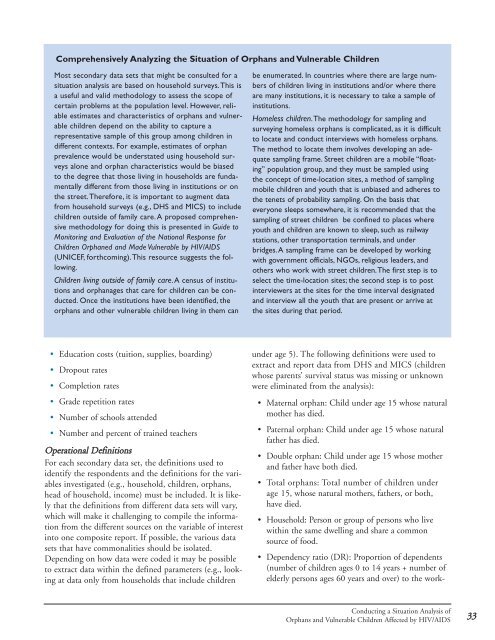Conducting a Participatory Situation Analysis of.pdf - Global HIV ...
Conducting a Participatory Situation Analysis of.pdf - Global HIV ...
Conducting a Participatory Situation Analysis of.pdf - Global HIV ...
Create successful ePaper yourself
Turn your PDF publications into a flip-book with our unique Google optimized e-Paper software.
Comprehensively Analyzing the <strong>Situation</strong> <strong>of</strong> Orphans and Vulnerable Children<br />
Most secondary data sets that might be consulted for a<br />
situation analysis are based on household surveys.This is<br />
a useful and valid methodology to assess the scope <strong>of</strong><br />
certain problems at the population level. However, reliable<br />
estimates and characteristics <strong>of</strong> orphans and vulnerable<br />
children depend on the ability to capture a<br />
representative sample <strong>of</strong> this group among children in<br />
different contexts. For example, estimates <strong>of</strong> orphan<br />
prevalence would be understated using household surveys<br />
alone and orphan characteristics would be biased<br />
to the degree that those living in households are fundamentally<br />
different from those living in institutions or on<br />
the street.Therefore, it is important to augment data<br />
from household surveys (e.g., DHS and MICS) to include<br />
children outside <strong>of</strong> family care.A proposed comprehensive<br />
methodology for doing this is presented in Guide to<br />
Monitoring and Evaluation <strong>of</strong> the National Response for<br />
Children Orphaned and Made Vulnerable by <strong>HIV</strong>/AIDS<br />
(UNICEF, forthcoming).This resource suggests the following.<br />
Children living outside <strong>of</strong> family care.A census <strong>of</strong> institutions<br />
and orphanages that care for children can be conducted.<br />
Once the institutions have been identified, the<br />
orphans and other vulnerable children living in them can<br />
be enumerated. In countries where there are large numbers<br />
<strong>of</strong> children living in institutions and/or where there<br />
are many institutions, it is necessary to take a sample <strong>of</strong><br />
institutions.<br />
Homeless children.The methodology for sampling and<br />
surveying homeless orphans is complicated, as it is difficult<br />
to locate and conduct interviews with homeless orphans.<br />
The method to locate them involves developing an adequate<br />
sampling frame. Street children are a mobile “floating”<br />
population group, and they must be sampled using<br />
the concept <strong>of</strong> time-location sites, a method <strong>of</strong> sampling<br />
mobile children and youth that is unbiased and adheres to<br />
the tenets <strong>of</strong> probability sampling. On the basis that<br />
everyone sleeps somewhere, it is recommended that the<br />
sampling <strong>of</strong> street children be confined to places where<br />
youth and children are known to sleep, such as railway<br />
stations, other transportation terminals, and under<br />
bridges.A sampling frame can be developed by working<br />
with government <strong>of</strong>ficials, NGOs, religious leaders, and<br />
others who work with street children.The first step is to<br />
select the time-location sites; the second step is to post<br />
interviewers at the sites for the time interval designated<br />
and interview all the youth that are present or arrive at<br />
the sites during that period.<br />
• Education costs (tuition, supplies, boarding)<br />
• Dropout rates<br />
• Completion rates<br />
• Grade repetition rates<br />
• Number <strong>of</strong> schools attended<br />
• Number and percent <strong>of</strong> trained teachers<br />
Operational Definitions<br />
For each secondary data set, the definitions used to<br />
identify the respondents and the definitions for the variables<br />
investigated (e.g., household, children, orphans,<br />
head <strong>of</strong> household, income) must be included. It is likely<br />
that the definitions from different data sets will vary,<br />
which will make it challenging to compile the information<br />
from the different sources on the variable <strong>of</strong> interest<br />
into one composite report. If possible, the various data<br />
sets that have commonalities should be isolated.<br />
Depending on how data were coded it may be possible<br />
to extract data within the defined parameters (e.g., looking<br />
at data only from households that include children<br />
under age 5). The following definitions were used to<br />
extract and report data from DHS and MICS (children<br />
whose parents’ survival status was missing or unknown<br />
were eliminated from the analysis):<br />
• Maternal orphan: Child under age 15 whose natural<br />
mother has died.<br />
• Paternal orphan: Child under age 15 whose natural<br />
father has died.<br />
• Double orphan: Child under age 15 whose mother<br />
and father have both died.<br />
• Total orphans: Total number <strong>of</strong> children under<br />
age 15, whose natural mothers, fathers, or both,<br />
have died.<br />
• Household: Person or group <strong>of</strong> persons who live<br />
within the same dwelling and share a common<br />
source <strong>of</strong> food.<br />
• Dependency ratio (DR): Proportion <strong>of</strong> dependents<br />
(number <strong>of</strong> children ages 0 to 14 years + number <strong>of</strong><br />
elderly persons ages 60 years and over) to the work-<br />
<strong>Conducting</strong> a <strong>Situation</strong> <strong>Analysis</strong> <strong>of</strong><br />
Orphans and Vulnerable Children Affected by <strong>HIV</strong>/AIDS<br />
33















